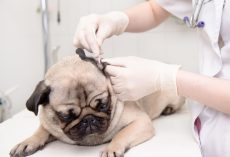Ticks are expanding their territory. Some say it is a resistance to pesticides. After all, after 50 years they might be getting used to the toxins meant to end their lives and keep your pooch in good health.
Still, there has to be a better way!
Preventing a Tick-Borne Infection in Your Pet
• Check for ticks daily, and don't overlook areas of your pet's body where ticks can hide, like between the toes, the underside of the toes, in the earflaps and around the tail base.
sesearch demonstrates that ticks must be attached to your dog for at least 24 hours in order for most disease-causing bacteria to be transmitted from the tick to your pet. That's why daily tick checks and removing ticks immediately are a huge part of reducing your dog's risk of acquiring a tick-borne disease.
If you prefer to err on the side of extreme caution, you can check your pet for ticks each time he may have been exposed (in other words, each time he visits an area outdoors that may harbor ticks). This is hands-down the safest and entirely non-toxic method of tick prevention.
• Use natural tick deterrents. There are dozens on the market, and although none of them will prevent 100 percent of tick bites 100 percent of the time, they may make your dog a less desirable target. Reducing the number of ticks on your dog by 50 to 80 percent is most certainly better than nothing, in my opinion.
• Focus on creating a healthy body. Unhealthy bodies tend to be over-parasitized. Healthy animals may have an occasional tick, but creating a vibrantly strong immune system through a balanced, fresh food diet, titering, and minimizing chemical exposure will help keep your pet safe.
• If you find a tick on your dog, be sure to remove it correctly. Don't use your bare hands because you can become infected by handling or crushing an infected tick. Wear gloves, or even better, use a tick-removing tool.
Grasp the tick very close to your pet's skin with a tick removal tool or a pair of tweezers. Carefully pull the tick's body away from the skin. Once it's off, flush it down the toilet. Then disinfect your dog's skin with soapy water or diluted povidone iodine (Betadine). I also recommend applying a drop of lavender oil to the bite.
Monitor the attachment site for the next few days. If you notice any irritation or inflammation of the skin, contact your veterinarian.
• Have your dog tested for tick-borne diseases no earlier than three to four weeks after removing a tick. The type of test to ask your veterinarian for is the SNAP 4Dx or Accuplex4 test, which is a screening blood test. If you don't have the 4Dx or Accuplex test done, you'll want to watch your dog closely for several months for any signs of loss of appetite, lethargy, change in gait, fever, intermittent limping — all the symptoms of potential tick-borne disease.
And just a thought, it’s always better to be proactive with prevention rather than waiting for your dog to exhibit symptoms. Any form of tick disease is harder to treat once active and the dog is infected or ill.
This summer, examine you pooch often for ticks and if your pooch has not had a blood test recently it’s a good idea. For more information please go to Healthy Pets.









